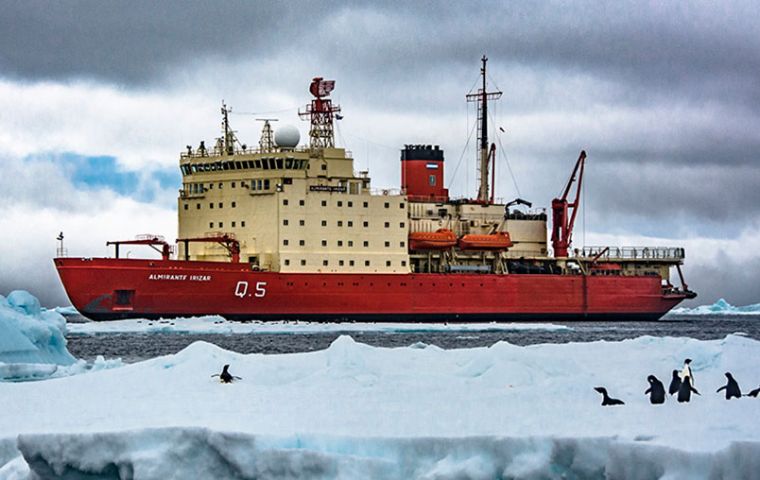MercoPress. South Atlantic News Agency
Biologists to monitor South Atlantic fauna during 2022 Antarctic campaign
 Argentine Antarctic Institute (IAA) scientists are onboard the Irízar
Argentine Antarctic Institute (IAA) scientists are onboard the Irízar The Argentina Navy's icebreaker ARA Almirante Irízar has added four biologists to its crew to monitor wildlife in the South Atlantic and around Antarctica, the news service Télam has reported.
The scientific team on board the Irízar plans to watch and record marine fauna to collect additional data on the relationship between animals and their food sources while the icebreaker supplies the 13 Argentine bases in Antarctica.
The observation of birds and marine mammals are part of a multi-year project, developed since 1987 and included in the Argentine Antarctic Program, whose implementation is in charge of the Argentine Antarctic Institute (IAA), which hopes to study changes in the marine ecosystem through the distribution, density, diversity and trophic relationships of marine birds and mammals in a global warming context.
The experts are to focus on marine areas where the fauna concentrates to feed and, therefore, require special care because they are critical for the cycles of life of all species.
The observation of birds and marine mammals that the Argentine Antarctic Institute has been carrying out since 1987 is key to determine “health” of the ecosystem in the Argentine Sea and Antarctica, and entails a State policy which has been underway since 1987, according to Télam.
Project Director José Luis Orgeira of the IAA's Department of Biology of Top Predators pointed out this year marked the 35th anniversary of the scientific undertaking, which seeks to carry out “a long-term monitoring not only of the marine environment and its environmental variables, but also of the species that inhabit it.”
Orgeira also explained that “Antarctica and its areas of influence is inhabited by some 35 species of seabirds and some 21 marine mammals.”
“Many of them are considered indicators of the state of health of the ecosystem, which means that if overtime we observe changes in their abundances or distributions, it is a clear sign that changes are occurring in their environment,” he added.
Orgeira also said that “due to environmental warming, large ice shelves are collapsing in different parts of Antarctica, particularly the Antarctic Peninsula and the Weddell Sea; this implies billions of tons of fresh water dumped into a salty medium, the sea,” the scientist went on.
“The oceans have a certain balance in their physical and chemical properties. When this balance is broken, their properties are altered and it may not be suitable for organisms that serve as food for birds, modify the speed and depth of their marine currents and many beneficial effects that the masses of water exert on the continents begin to disappear. It is something like a domino effect,” Orgeira elaborated.
“These are the changes that birds and marine mammals perceive and that manifest themselves over time, so the more data we have, the more faithful the predictive models of changes in the environment and the life cycles of species will be,” the biologist concluded.
(Source: Télam)




Top Comments
Disclaimer & comment rulesCommenting for this story is now closed.
If you have a Facebook account, become a fan and comment on our Facebook Page!